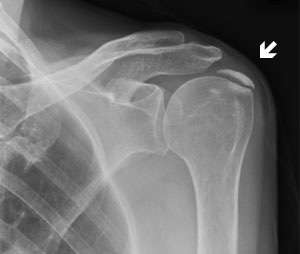Calcific tendinitis
Background
- Self-limiting disorder of calcium deposition within one or more tendons of the rotator cuff
- With time, the calcium undergoes painful resorption with subsequent tendon healing
- Middle-aged patients are most commonly affected (rarely seen in patients >70yrs)
- Adhesive capsulitis is most common complication
Clinical Features
Precalcific phase
- Fibrocartilaginous metaplasia of the tendon
- Pain-free
Calcification phase
- Formative phase
- characterized by cell-mediated calcific deposits
- +/- Shoulder pain
- Resting phase
- lacks inflammation or vascular infiltration
- +/- pain
- Resorptive phase (1-2 wks)
- characterized by phagocytic resorption and vascular infiltration
- most painful phase
- Sudden onset of severe pain, usually at rest, worse at night
- Any shoulder motion reproduces significant pain
- TTP over proximal humerus near tendinous insertion of rotator cuff
Post-calcific phase
- Variable levels of pain and shoulder dysfunction
Differential Diagnosis
Shoulder and Upper Arm Diagnoses
Traumatic/Acute:
- Shoulder Dislocation
- Clavicle fracture
- Humerus fracture
- Scapula fracture
- Acromioclavicular injury
- Glenohumeral instability
- Rotator cuff tear
- Biceps tendon rupture
- Triceps tendon rupture
- Septic joint
Nontraumatic/Chronic:
- Rotator cuff tear
- Impingement syndrome
- Calcific tendinitis
- Adhesive capsulitis
- Biceps tendinitis
- Subacromial bursitis
Refered pain & non-orthopedic causes:
- Referred pain from
- Neck
- Diaphragm (e.g. gallbladder disease)
- Brachial plexus injury
- Axillary artery thrombosis
- Thoracic outlet syndrome
- Subclavian steal syndrome
- Pancoast tumor
- Myocardial infarction
- Pneumonia
- Pulmonary embolism
Evaluation

Calcific tendinitis
- Imaging
- Plain films will show calcification in the tendon(s) of the rotator cuff
- Note: calcification is not specific for calcific tendinitis (may occur in asymptomatic patients)
Management
- Nonoperative management is successful in most cases
- NSAIDs
- Physical therapy
- Stretch and strengthening
- Avoid immobilization
- Rest shoulder in abduction on back of a chair as soon as tolerable
- Sleep with pillow beneath axilla
- Avoid immobilization
- Corticosteroid injections
Disposition
- Primary care referral within 1wk
- If chronic, may consider ortho referral for operative management
See Also
- Shoulder diagnoses
- Biceps Tendinitis
References
This article is issued from
Wikem.
The text is licensed under Creative
Commons - Attribution - Sharealike.
Additional terms may apply for the media files.